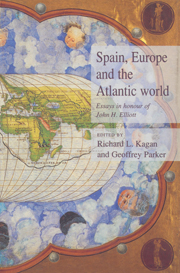Book contents
- Frontmatter
- Contents
- Notes on contributors
- Acknowledgements
- List of abbreviations
- Sir John Elliott: an appreciation
- Introduction
- PART I Power and propaganda: the world of the court
- PART II The pattern of society: community and identity in Habsburg Spain
- PART III Spain and its empire
- 10 David or Goliath? Philip II and his world in the 1580s
- 11 Olivares, the Cardinal-Infante and Spain's strategy in the Low Countries (1635–1643): the road to Rocroi
- 12 Conquest after the conquest: the rise of Spanish domination in America
- 13 Heeding Heraclides: empire and its discontents, 1619–1812
- 14 Why were Spain's special overseas laws never enacted?
- Index
12 - Conquest after the conquest: the rise of Spanish domination in America
Published online by Cambridge University Press: 04 August 2010
- Frontmatter
- Contents
- Notes on contributors
- Acknowledgements
- List of abbreviations
- Sir John Elliott: an appreciation
- Introduction
- PART I Power and propaganda: the world of the court
- PART II The pattern of society: community and identity in Habsburg Spain
- PART III Spain and its empire
- 10 David or Goliath? Philip II and his world in the 1580s
- 11 Olivares, the Cardinal-Infante and Spain's strategy in the Low Countries (1635–1643): the road to Rocroi
- 12 Conquest after the conquest: the rise of Spanish domination in America
- 13 Heeding Heraclides: empire and its discontents, 1619–1812
- 14 Why were Spain's special overseas laws never enacted?
- Index
Summary
The Spanish military conquests on the American mainland between, roughly, 1520 and 1540, are justly famous, or infamous, episodes in the history of European expansion. In those two decades a small number of Spaniards, probably not above 10,000 even if late-comers and people behind the front lines are counted, overcame native polities containing many millions in central and southern Mexico, Central America and the regions of South America we now know as Colombia, Ecuador, Peru, Bolivia and Chile. Great and sometimes acrimonious controversy still surrounds the question of how many millions of Indians there were. The answer will probably never be known for certain. The most sober study of the Peruvian case suggests a range of 4–12 or even 15 million; and for central and southern Mexico, serious arguments have been made for figures from 6 to 25 million. These are the best-studied regions – the heart of the Inca empire, and almost the whole of the Aztecs'. The pre-conquest populations of other areas are still less precisely (if that is the word) known. For understanding the conquests, the numbers in any case do not matter much. Whether high or low estimates are taken, the invaders were still outnumbered by thousands to one.
Controversy abounds, too, over the means of conquest, though it is less heated, and has more to do with the ranking of explanations than with identifying them.
- Type
- Chapter
- Information
- Spain, Europe and the AtlanticEssays in Honour of John H. Elliott, pp. 296 - 315Publisher: Cambridge University PressPrint publication year: 1995

